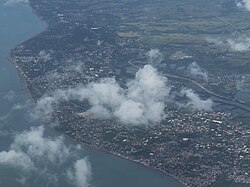Arevalo
La Villa Rica de Arévalo | |
|---|---|
 Arevalo aerial view | |
| Nickname: Flower Capital of Iloilo | |
 Location within Iloilo City | |
 | |
| Coordinates: 10°41′09″N 122°30′42″E / 10.68583°N 122.51167°E | |
| Country | Philippines |
| Region | Western Visayas (Region VI) |
| Province | Iloilo (geographically only) |
| City | Iloilo City |
| Congressional District | Lone district of Iloilo City |
| Founded |
|
| Incorporated (as district) | July 16, 1937 |
| Founded by | Gonzalo Ronquillo de Peñalosa |
| Barangays | 13 (see Barangays) |
| Government | |
| • Mayor | Jerry Treñas (Mayor of Iloilo City) |
| Area | |
| • Total | 7.58 km2 (2.93 sq mi) |
| Population (2020 census) | |
| • Total | 55,476 |
| • Density | 7,316.80/km2 (18,950.4/sq mi) |
| Demonym(s) | Arevaleño; Villahanon |
| Time zone | UTC+8 (Philippine Standard Time) |
| ZIP code | 5000 |
| Area code | 33 |
| Festival(s) | Paraw Regatta Festival – Third Weekend of February |
| Patron saint | Santo Niño de Arévalo |
| Feast day | Third Sunday of January |
| Native languages | Hiligaynon |
Villa de Arevalo ([ˈbiʝa ðe aˈɾeβalo]; [ˈbiːljɐ dɛ ʔɐˌɾɛːbɐˈlo]), commonly known as simply Villa or Arevalo, is a district in Iloilo City, Philippines. It is the westernmost district of Iloilo City and shares its border with Oton to the west, in the province of Iloilo, on the island of Panay in the Western Visayas region.[1] According to the 2020 census, it has a population of 55,476 people.

The district is known for its heritage and cultural landmarks, including the Camiña Balay nga Bato, a 19th-century heritage house,[2] and Villa Beach, which features several resorts and popular local restaurants and bars.
Notable landmarks in Arevalo include the Archdiocesan Shrine of Santo Niño de Arevalo, which houses the Santo Niño de Arévalo, the third oldest Santo Niño (Infant Jesus) image in the Philippines.[3][4] Arevalo is often referred to as the "Flower Capital of Iloilo" due to the abundance of potted plants, flowers, bouquets, and wreaths sold in the district.[5] The district is also renowned for its firecrackers and fireworks.[6]
- ^ "About Iloilo City". Iloilo City Government. Archived from the original on January 21, 2012. Retrieved February 20, 2012.
- ^ Cummings, E. E. (November 19, 2016). "Camiña Balay nga Bato: Inside Iloilo's Heritage House by the River". Simply Philippines. Retrieved August 11, 2022.
- ^ "Sto. Niño de Arevalo Parish (Villa, Arevalo Iloilo)". Visita Iglesia: A Visit to the Sanctuarium of Catholic Faith. July 28, 2009. Archived from the original on May 1, 2011. Retrieved April 4, 2011.
- ^ "You are being redirected..." www.panaynews.net. Retrieved July 14, 2022.
- ^ "La Villa de Arevalo - Flower capital of Iloilo". Explore Iloilo. Retrieved August 11, 2022.
- ^ Admin (January 30, 2020). "Arevalo Iloilo City Complete and Updated Guide". Iloilo Ph. Retrieved August 11, 2022.

